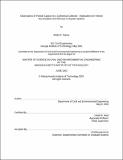| dc.contributor.advisor | Heidi M. Nepf. | en_US |
| dc.contributor.author | Palmer, Molly R., 1978- | en_US |
| dc.contributor.other | Massachusetts Institute of Technology. Dept. of Civil and Environmental Engineering. | en_US |
| dc.date.accessioned | 2005-05-19T15:18:04Z | |
| dc.date.available | 2005-05-19T15:18:04Z | |
| dc.date.copyright | 2003 | en_US |
| dc.date.issued | 2003 | en_US |
| dc.identifier.uri | http://hdl.handle.net/1721.1/16922 | |
| dc.description | Thesis (S.M.)--Massachusetts Institute of Technology, Dept. of Civil and Environmental Engineering, 2003. | en_US |
| dc.description | Includes bibliographical references (leaves 73-75). | en_US |
| dc.description | This electronic version was submitted by the student author. The certified thesis is available in the Institute Archives and Special Collections. | en_US |
| dc.description.abstract | Capture of suspended particles by cylindrical collectors is an important mechanism in many aquatic processes, such as larval settlement, suspension feeding, and vegetative filtration. The collector Reynolds number (Rec), based on the collector diameter, typically ranges from 1-1000 in aquatic environments. No analytical solutions exist to describe capture efficiency in this range. Laboratory experiments are used to measure capture efficiency of a single cylinder as a function of Rec and particle ratio, R, which is the ratio of particle diameter to collector diameter. Rec is varied from 50 to 500 and three values of R are used: 0.03, 0.015, and 0.008. For smooth cylinders, capture increases with both Rec and R, but is more strongly dependent on R. This indicates that in aquatic systems, where flow velocity and suspended particle type and size are fixed, proportionally more capture will occur on the smallest collectors (those with largest R). An empirical equation is developed that predicts capture to single cylinders. Furthermore, published data for an experiment in which particles are collected by branched structures can be predicted by the empirical equation. This indicates that capture to individual cylindrical branches within a compound structure can be predicted by single-cylinder efficiencies. In addition, a model of a Spartina alterniflora wetland is presented which shows that the mechanism of particle capture can remove a significant portion of suspended particles. Finally, experiments in which roughness elements were added to the collectors showed that capture increased when compared to the smooth cases. A model is presented based on the added drag associated with the roughness elements that describes when roughness elements can enhance, and under certain circumstances, diminish capture. | en_US |
| dc.description.statementofresponsibility | by Molly R. Palmer. | en_US |
| dc.format.extent | 75 leaves | en_US |
| dc.format.extent | 1249299 bytes | |
| dc.format.extent | 1249048 bytes | |
| dc.format.mimetype | application/pdf | |
| dc.format.mimetype | application/pdf | |
| dc.language.iso | eng | en_US |
| dc.publisher | Massachusetts Institute of Technology | en_US |
| dc.rights | M.I.T. theses are protected by copyright. They may be viewed from this source for any purpose, but reproduction or distribution in any format is prohibited without written permission. See provided URL for inquiries about permission. | en_US |
| dc.rights.uri | http://dspace.mit.edu/handle/1721.1/7582 | |
| dc.subject | Civil and Environmental Engineering. | en_US |
| dc.title | Observations of a particle capture on a cylindrical collector : implications for particle accumulation and removal in aquatic systems | en_US |
| dc.type | Thesis | en_US |
| dc.description.degree | S.M. | en_US |
| dc.contributor.department | Massachusetts Institute of Technology. Department of Civil and Environmental Engineering | |
| dc.identifier.oclc | 52872472 | en_US |
